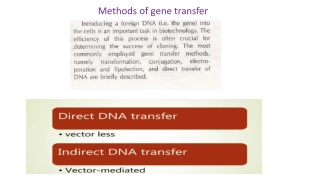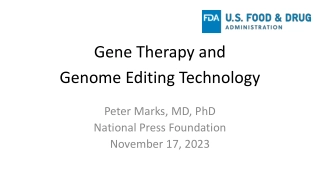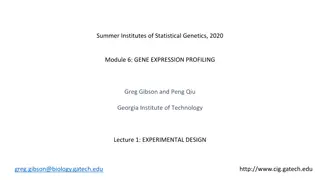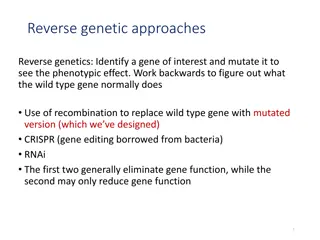Understanding Gene Therapy: Types, Techniques, and Applications
Gene therapy involves introducing DNA into a patient to treat genetic diseases by correcting disease-causing mutations. There are two types of gene therapy: somatic gene therapy and germline gene therapy, each with different implications. Techniques such as gene augmentation therapy and gene inhibition therapy are used to address specific types of diseases at the cellular level. Gene therapy shows promise in treating genetic disorders like muscular dystrophy and cystic fibrosis.
Download Presentation

Please find below an Image/Link to download the presentation.
The content on the website is provided AS IS for your information and personal use only. It may not be sold, licensed, or shared on other websites without obtaining consent from the author. Download presentation by click this link. If you encounter any issues during the download, it is possible that the publisher has removed the file from their server.
E N D
Presentation Transcript
Gene therapy Dr Nadal Abdulameer Ali
Gene therapy is when DNA is introduced into a patient to treat a genetic disease. The new DNA usually contains a functioning gene to correct the effects of a disease-causing mutation. Gene therapy uses sections of DNA (usually genes) to treat or prevent disease. The DNA is carefully selected to correct the effect of a mutated gene that is causing disease. The technique was first developed in 1972 but has, so far, had limited success in treating human diseases. Gene therapy may be a promising treatment option for some genetic diseases, including muscular dystrophy and cystic fibrosis.
There are two different types of gene therapy depending on which types of cells are treated: Somatic gene therapy: transfer of a section of DNA to any cell of the body that doesn t produce sperm or eggs. Effects of gene therapy will not be passed onto the patient s children. Severe Combined Immunodeficiency Disease (SCID) is due to a defective gene for Adenosine Deaminase (ADA). A retrovirus which is capable of transferring it's DNA into normal eukaryotic cells (transfection)
Germline gene therapy: transfer of a section of DNA to cells that produce eggs or sperm. Effects of gene therapy will be passed onto the patient s children and subsequent generations
Gene therapy techniques: There are several techniques for carrying out gene therapy. These include: 1- Gene augmentation therapy This is used to treat diseases caused by a mutation that stops a gene from producing a functioning product, such as a protein. This therapy adds DNA containing a functional version of the lost gene back into the cell. The new gene produces a functioning product at sufficient levels to replace the protein that was originally missing.
This is only successful if the effects of the disease are reversible or have not resulted in lasting damage to the body. For example, this can be used to treat loss of function disorders such as cystic fibrosis by introducing a functional copy of the gene to correct the disease.
2- Gene inhibition therapy This therapy is suitable for the treatment of infectious diseases, cancer and inherited disease caused by inappropriate gene activity. The aim is to introduce a gene whose product either: inhibits the expression of another gene or interferes with the activity of the product of another gene.
The basis of this therapy is to eliminate the activity of a gene that encourages the growth of disease- related cells. For example, cancer is sometimes the result of the over-activation of an oncogene (gene which stimulates cell growth). So, by eliminating the activity of that oncogene through gene inhibition therapy, it is possible to prevent further cell growth and stop the cancer in its tracks.
3- Killing of specific cells This type is suitable for diseases such as cancer that can be treated by destroying certain groups of cells. The aim is to insert DNA into a diseased cell Which leading to cell death . This can be achieved in one of two ways: the inserted DNA contains a suicide gene that produces a highly toxic product, which kills the diseased cell. 2-The inserted DNA causes expression of a protein that marks the cells so that the diseased cells are attacked by the body s natural immune system. It is essential with this method that the inserted DNA is targeted appropriately to avoid the death of cells that are functioning normally
How is DNA transfer done? A section of DNA/gene containing instructions for making a useful protein is packaged within a vector, usually a virus, bacterium or plasmid. The vector acts as a vehicle to carry the new DNA into the cells of a patient with a genetic disease. Once inside the cells of the patient, the DNA/gene is expressed by the cell s normal machinery leading to production of the therapeutic protein and treatment of the patient s disease.
Challenges of gene therapy Delivering the gene to the right place and switching it on: it is crucial that the new gene reaches the right cell. Delivering a gene into the wrong cell would be inefficient and could also cause health problems for the patient. Even once the right cell has been targeted the gene has to be turned on. Cells sometimes obstruct this process by shutting down genes that are showing unusual activity. Avoiding the immune response: The role of the immune system is to fight off intruders. Sometimes new genes introduced by gene therapy are considered potentially - harmful intruders. This can spark an immune response in the patient that could be harmful to them. Scientists therefore have the challenge of finding a way to deliver genes without the immune system noticing . This is usually by using vectors that are less likely to trigger an immune response.
Making sure the new gene doesnt disrupt the function of other genes: Ideally, a new gene introduced by gene therapy will integrate itself into the genome of the patient and continue working for the rest of their lives.There is a risk that the new gene will insert itself into the path of another gene, disrupting its activity. This could have damaging effects, for example, if it interferes with an important gene involved in regulating cell division, it could result in cancer. The cost of gene therapy: Many genetic disorders that can be targeted with gene therapy are extremely rare. Gene therapy therefore often requires an individual, case-by-case approach. This may be effective, but may also be very expensive.























